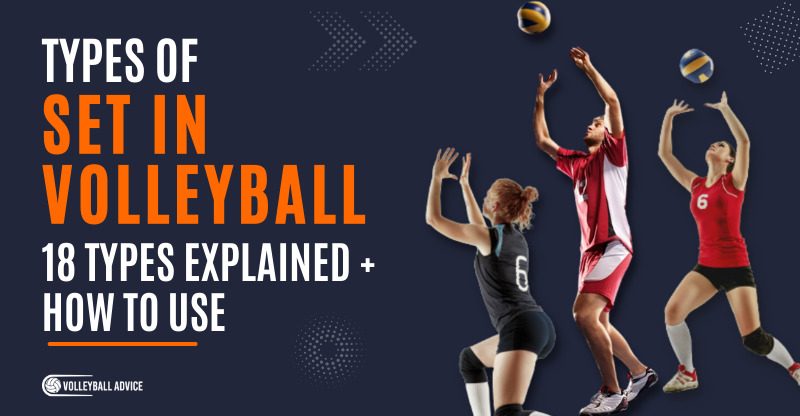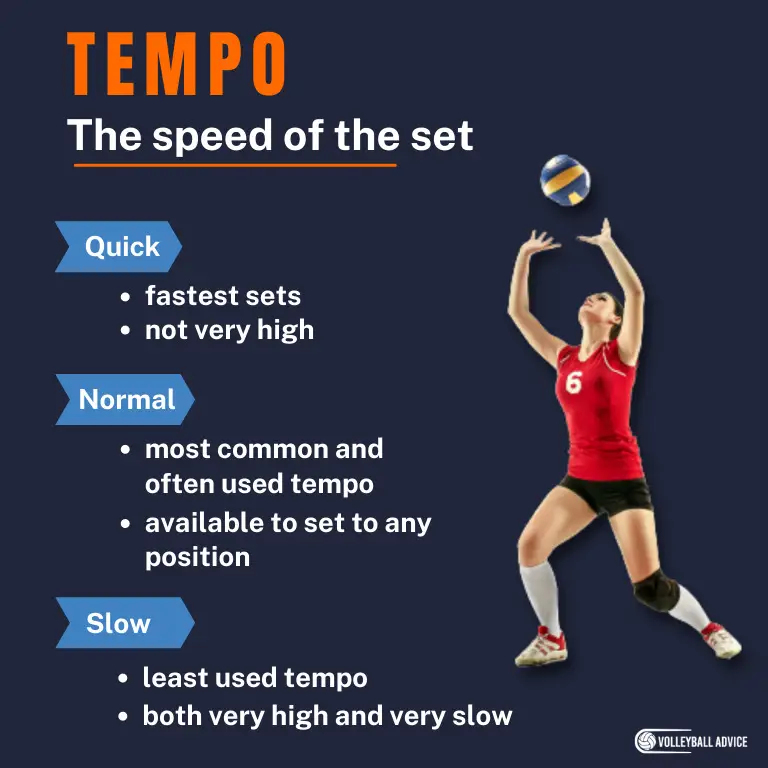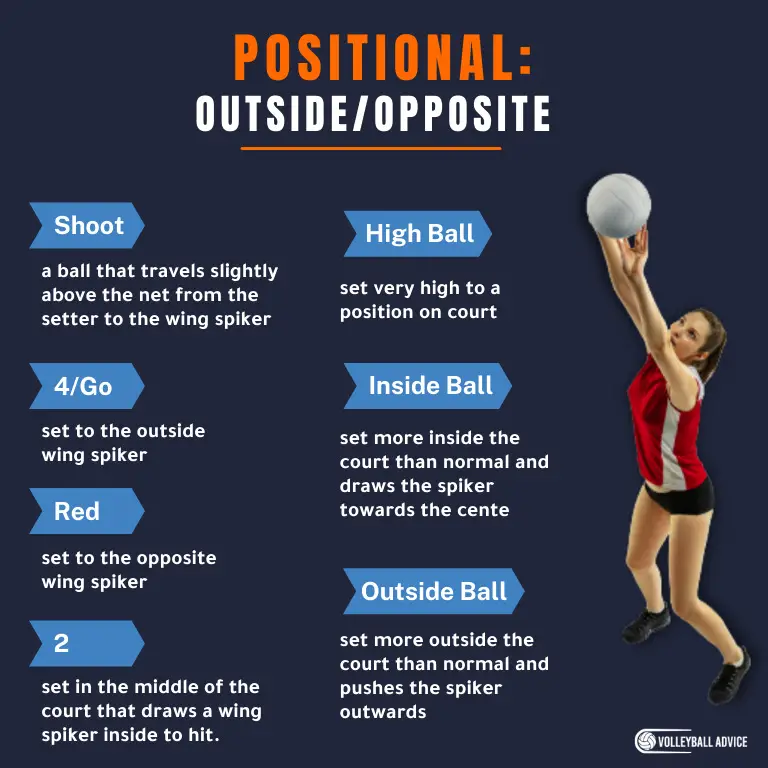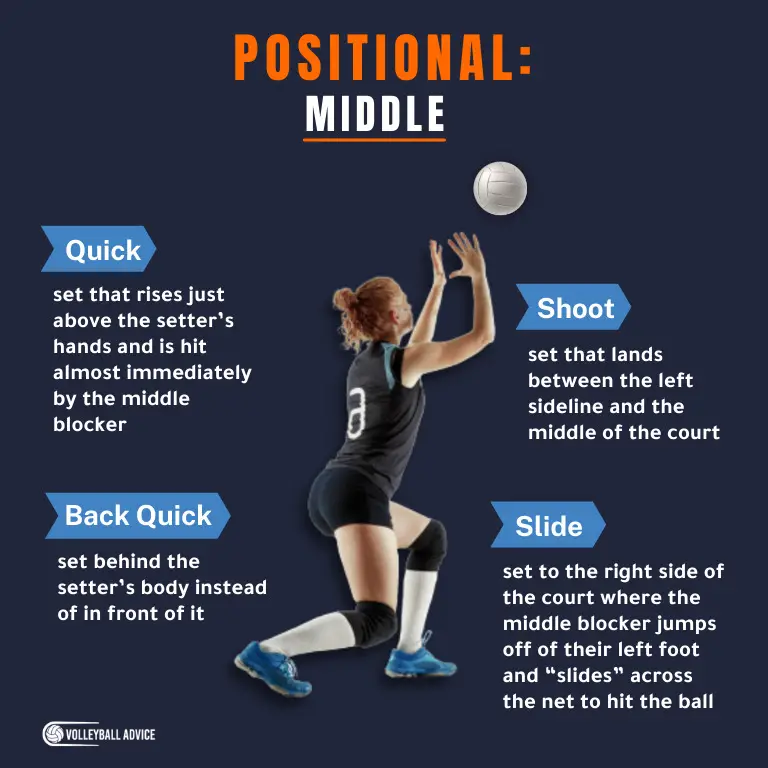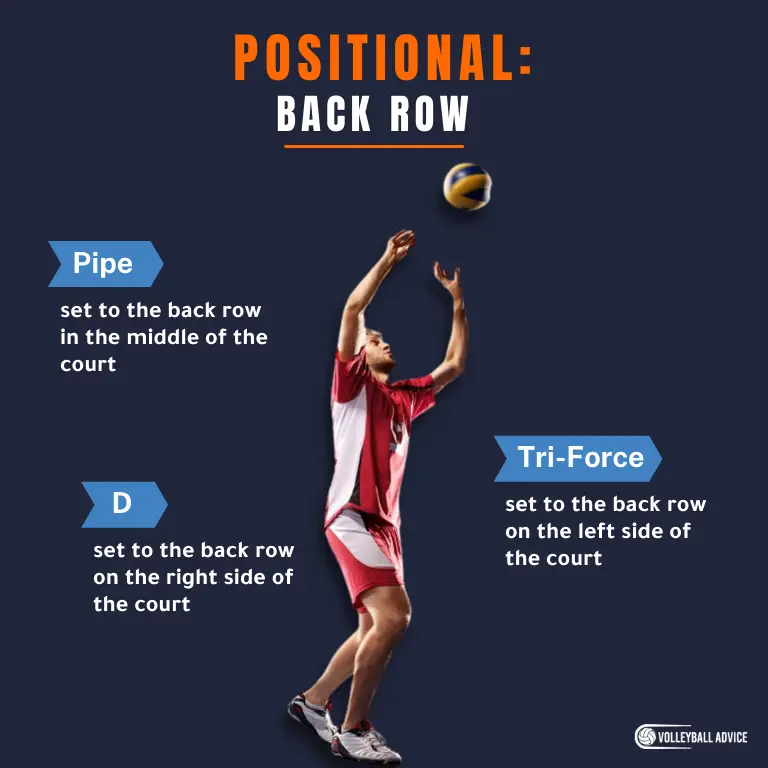Types of Sets In Volleyball: 18 Types Explained + How To Use
“A team is only as good as their setter”
You might be the best hitter in the world, but without a good set your talents will be limited at best, totally wasted at worst.
The setter is the “control tower” of the team, the system that controls how the team responds to a given situation. While the captain might call the shots, it’s the setter that controls the game.
So, what are the types of sets in volleyball? Setting in volleyball is broken into three main categories or types that build upon one another: tempo (the speed of the set), positional (where the ball goes), and combination (how the setter uses the court).
While other positions on court need only be familiar with the types of setting that they are given to hit, a setter’s job is made much harder by the need to know every set for every player. Game knowledge and awareness of the state of the game, and even understanding how a teammate is performing on a given day, are all essential to succeeding as a setter.
Today, I’m going to break down the many different types of sets and how to utilize them with different types of players. By the end of this article, you should be able to:
- Identify the different types of sets
- Know how to use them
- Begin thinking about possible combinations
What is Setting A Volleyball?
Setting is the action of passing a ball – usually overhanded with hands in a setting position – to a spiker so that they can hit over the net in the attempt to score.
Anyone can set a volleyball, and it doesn’t necessarily have to be a “set” as we think of it, with hands upright and in setting position. A forearm pass can be a set, or a well-timed bounce off of a player’s foot, but these have too little accuracy and consistency to be used regularly.
A setter is the position on court responsible for the set, and will normally take the second ball after the pass in order to set to a spiker. Accuracy, consistency, and good decision making are the tenets of a good setter, and good technique is an absolute must.
The Basics Of Setting A Volleyball
To set, make a triangle with your thumbs and forefingers, your other fingers making a basket shape.
Catch the ball in the center of the triangle, allowing it to land gently within the “basket”, and immediately flick your wrists outward while pushing up with your arms and legs to give it height. Make sure to move forward, through the ball.
The resulting set should have little-to-no spin and stay in your hands for only an instant. This is a set.
Keeping the ball in your hands too long or contacting it off-center, which results in an obvious, spinning ball that flies off-target, are against the rules in volleyball and result in an immediate point to the other team.
To prevent this, setters must have “soft hands” which catch the ball gently yet release powerfully, and always move their feet underneath the ball. When these things have been accomplished, and the technique satisfied, it is time to learn the types of setting.
Types of Sets: Tempo
Tempo is the first and most basic aspect of setting, and has to do with the speed of the set. Because of this, it also deals with the height of the set, as both are used to control the timing and affect each other.
Tempo is important because it establishes an agreement with your spikers when they are going to start their approach and hit the ball.
Telling them to hit a quick ball and setting them a slow will result in them already landing from the first jump and scrambling to get back in the air for an unexpected tempo. The hit will be less powerful and your team will be at a disadvantage.
Therefore, communication is key.
Tempo is also important because it lets the setter dictate the pace of the game and respond to blocks.
Giving different players different tempos to hit during the same set allows you options and can confuse the defense. Establish hand signals with your spikers and use them covertly to hide your next move.
While some teams describe these as “first”, “second”, and “third” tempos, I will be using the terms “quick”, “normal”, and “slow” as they help describe the motion better. Both mean the same thing, so use what works for you.
The three tempos are:
- Quick
- Normal
- Slow
1. Quick
Quick tempos are the fastest sets in the game and aren’t set very high. The point of a quick is to be faster than the defense can react to and allow the spiker to hit the ball before a block has even formed.
This kind of set can be difficult for some setters, because the smallest deviation causes big problems for the spiker if they’re not expecting it.
Consistency is key here rather than trying to adapt to your hitter, as they will also be changing things to adapt to you. Stick with your set once you find a good height and groove for it and let your spikers get used to it. This will allow you to sync up much faster.
Quick sets are the core of what makes middle blockers effective as hitters and are used for almost every spike they hit.
Outsides and opposite hitters also have a quick, however, called the “shoot” which is fired parallel to the top of the net like a laser. We’ll discuss the differences between these under the “Positional” heading below.
2. Normal
Normal tempos are the most common tempo of setting and most often used. Available to set to any position, they have a large window for error, and timing can vary much more than “quicks”.
This kind of set is most commonly used to set the outside or opposite spikers on the wings, and can also be used to set the back row (hitters in rotational positions 1, 6, or 5 who can only hit from behind the 10 foot line). It offers flexibility and trusts the spikers’ talents to get by the block by making it very easy to hit.
This tempo should be a habit and feel like second nature to perform. Practice your accuracy and remember to move forward through your set as you go.
3. Slow
Slow sets are the least used tempo of setting, and are both very high and very slow.
Used mostly in combination hitting for a spiker to hit a ball over the head of a teammate who is descending from an approach jump, slow tempo setting helps stagger attacks if the block is reading the spikers’ intentions too well at a normal tempo.
Another use for this kind of set is being used as a safety set to buy time if several players are trying to recover from a dive or ran wide to pass a ball back to court.
Making sure you have all your players will cover the holes in your defense and prevent silly mistakes after a great receive.
Check out this guide: Hand Position For Setting In Volleyball (7 Steps)
Types of Sets: Positional
Positional types of setting affects both who the ball is set to (aka what position on court) and how. This category of setting lists the commonly-referred to names of the different types of attacks and sets which are used for each position.
This type of setting relies equally on technique and game knowledge to succeed.
For instance, a front row setter cannot set an opposite in the front row (near the net) because they are opposite one another – the opposite is in the back row.
Players in the back row (positions 1, 6, and 5) cannot attack from in front of the ten foot line and will forfeit the point if they do.
While tempo must be learned to teach setters what their options are, positional setting teaches setters how to use these options.
Outside/Opposite
The outside and opposite spikers, also known as “wing spikers”, hit the exact same kinds of balls despite occupying opposite sides of the court.
This is because whatever can be done on the outside should be reflected (or “mirrored”) on the opposite, and this is where their names come from.
While forward setting and back setting are very different, this article’s goal is to establish the types of setting rather than the technique.
Check out our article on “How to Set” for further details!
Types of Sets:
- Shoot
- 4/Go
- Red
- 2
- High Ball
- Inside Ball
- Outside Ball
4. Shoot
A shoot is a quick tempo ball that travels slightly above the net from the setter to the wing spiker.
While this is normally set a specific distance, different setters might use an area of court as a target, or even adjust to the spiker’s movements on the fly. Talk to your setter and confirm how they execute the set before practice, and be open to changes as you practice.
5. 4/Go
A 4 is a normal tempo ball that is set to the outside wing spiker.
Also known as a “go” ball if set to the outside, this ball is the bread and butter of spiking and the most common set you will perform as a setter. This is the set that offers the hitter the most agency in their approach, targeting, and swing, and should be used boldly with spikers of all talent levels. Use often.
6. Red
A red is a normal tempo ball that is set to the opposite wing spiker.
Alternatively known as a “back 4”, this set is exactly the same height and tempo of a “go” ball but set behind the setter to the opposite instead of outside spiker. Extremely reliable, a good opposite hitter can relieve the burden from your outside “ace” and put the pressure on the opposition from a different side.
7. 2
The little brother of a “go”, a 2 is a normal tempo ball that is set in the middle of the court that draws a wing spiker inside to hit.
Whether set intentionally or, as occasionally happens, accidentally, this set combos well with middle players running wide for a quick or shoot of their own. This is a great ball to give your wing spikers more space to hit or to move them away from the block and mix things up a little.
8. High Ball
A high ball, sometimes called a “hut”, is a ball that is set very high to a position on court.
Most commonly, this ball is played from the opposite position over to the outside when the setter is caught out and the set must be made out of rotation (or simply, not ideally). This can also be played vice versa, from the outside to the opposite spiker.
A high ball is great for controlling tempo, and can be used within normal tactics and rotations to throw the defense off by a cunning setter looking to pull off a combo. We’ll talk more about this in the “Combinations” section later on.
9. Inside Ball
An inside ball is a ball that is set more inside the court than normal and draws the spiker towards the center.
This type of set is often set accidentally, but if used intentionally can help give your spikers an edge against the block by subtly shifting their point of contact. Use when the line blocker is extremely tenacious to give your spiker a little bit more court to play with and hit to.
10. Outside Ball
An inside ball is a ball that is set more outside the court than normal and pushes the spiker outwards.
Similar to the “inside ball”, this type of set is often set accidentally by inexperienced setters. Use this when the block sets up on a position on court rather than following you in order to hit angles you normally wouldn’t be able to. Be careful not to set too far and limit your spiker’s options entirely though!
Middle
Middle blockers may be built tall and lanky, but their spiking game is all about speed. The types of setting that create their hitting repertoire reflects this with almost no exceptions, and most fall under the “quick” tempo; their main type of hit is even named after it!
Types of Set:
- Quick
- Back Quick
- Shoot
- Slide
11. Quick
A quick is a set that rises just above the setter’s hands and is hit almost immediately by the middle blocker.
Also known as a “1”, this type of set is deadly and hard to block if you’re not expecting it, resulting in a point almost every time with proper contact and timing. The downside is equally brutal: it’s extremely hard to sync with your middle blocker.
There’s no feeling quite as hopeless for spikers than seeing the set that was meant for you sail away out of reach, unable to be hit. For setters, it’s equally as frustrating to set a good ball that doesn’t get used. Quicks require trust and understanding between middle blockers and setters perhaps more than any other type of set, and because of this a bond usually forms between the two.
12. Back Quick
A back quick is a quick that is set behind the setter’s body instead of in front of it.
Also known as a “Back 1”, this set is used to fool a blocker who is consistently stopping a normal quick. The middle steps behind the setter and suddenly, the court is open and the block is gone.
This set is good to use in order to open the court up for your middle blocker or to mix in during combinations. You can even have your opposite come in to hit a back quick while your middle runs a normal quick simultaneously to surprise the opposition.
Make them ask the question: where is it going to go? The great thing about quicks is that it gives them no time to figure it out.
13. Shoot
A shoot is a quick tempo set that lands between the left sideline and the middle of the court.
This is exactly the same as a wing spiker shoot, but it doesn’t travel as far. Use this to give your middle blocker a different area to hit from, or to connect while setting from off the net.
14. Slide
A slide is a quick tempo set to the right side of the court where the middle blocker jumps off of their left foot and “slides” across the net to hit the ball.
Similar to a “shoot”, use this set to give your spiker space is a simple “back quick” won’t cut it. Be extra careful as a spiker if hitting this, as jumping off of one foot and moving through the air creates the perfect situation for an ankle injury.
Back Row
Back Row spikers are those players who have rotated out of the front positions (2, 3, 4) to behind the ten foot line in positions 1, 6, and 5.
While this article isn’t aimed towards delving into the specific rules of attack, there are a couple relevant guidelines that all players should know.
- First, back row players are prohibited from attacking (jumping and spiking) on or in front of the ten foot line. This will result in an instant loss of point.
- Second, the libero is prohibited from attacking anywhere on the court, and is additionally prohibited from setting in front of the ten foot line.
These rules are in place for good reason and help keep the court safe and orderly despite the twelve people running about at high speeds after a small, inflatable ball, but they also define how the game is played.
The libero cannot attack, so is useless in the front row; this relegates them to the backrow permanently. Luckily, as defensive specialists, this is exactly where they want to be. Not being able to set in front of the ten foot line is a bigger problem though, as it necessitates the setter to be always available and limits the amount of spikers at one time.
The way teams get around this is via the back row attacks.
When a setter, outside, and libero are backcourt, there are three front court options and one back court option to choose from when setting. When the setter rotates front, however, this makes the options evenly split 2-2. If the libero rotates off at any point, this increases the attacking options again to 3-2.
The back row is an often untapped asset in a team’s offensive potential, and the setter that can unlock this will find much greater success.
Let’s talk about the types of setting for the back row:
- Pipe
- D
- Tri-Force
15. Pipe
A pipe is a normal or slow tempo ball set to the back row in the middle of the court.
The outside hitters are some of your strongest and most powerful hitters on the team, and this type of set allows you to utilize them even when they’re in the back row. Best used with a middle blocker faking a “quick” hit in front, the pipe is screened until the last second.
16. D
A D is a normal or slow tempo ball set to the back row on the right side of the court.
This set is identical to a pipe but is hit on the right side by the opposite hitter instead. This is a great option when the opposite hitter is your primary scorer and gives your team the advantage with the natural cross hit being angled towards the opposing setter. This takes away their agency for the next point and can give your team the edge to score.
17. Tri-Force
The tri-force is a normal or slow tempo ball that is set to the back row on the left side of the court.
This set is unique because it can only be played on one specific rotation – when the middle blocker rotates back to serve and the libero is no longer on court. This middle blocker will then be able to hit from position 5, an unusual tactic that opposing teams might not expect. Use if your middle blocker is a great deep court hitter.
Additionally, if your setter is front court, all three back row attacks are available as options. This is what gives this positional set its name: the tri-force.
18. Bonus: A Setter Dump
An honorable mention to types of setting in the positional category, a “setter dump” is less of a set than an attack over the net.
To execute this, a setter plays the ball over the net into an open space on the first or second ball (instead of third ball, which a spiker usually hits). It can be either gentle and fall close to the net, pushed deep, or even spiked if the setter is skilled enough.
The limitation for this is that the setter must be in the front row for this to work, otherwise it would be considered a rules violation for back row attacking and cost your team the point.
Use against teams who are slow on their feet or not paying attention. A well-timed setter dump can shift the momentum of the game more than one might expect.
Types of Sets: Combination
Combination setting is the type of setting in which setters use the court to their advantage, choosing between the players at their disposal, the strength of the defense, the positions to set to, tempo, and more.
A near infinite amount of combos exist, combining different players running individual tempos in every different position imaginable, and because of this it is the most difficult type of setting.
Combinations (or combos) are almost an art form, and every setter has their own flair and spin on the basic concepts.
Just as much as the setter’s ability, the experience of the players is a key component to running effective combos. Together, they form an organic relationship that continues to grow.
Combos are the purest expression of setting because they demonstrate a setter’s mastery of their art while creating a work of beauty, power, symmetry, or more. While two combos might look similar, no two will ever be the same.
Setters, I challenge you to create a combo and pitch it to your team.
Make a hand sign and have fun with it. If you already run combos, try adding something to it or making something new. It doesn’t always need to be useful – goofiness is just as important in developing players as the seriousness of competition. A balance is always best.
Other Resources
- 10 Types of Serves in Volleyball
- 7 Types of Passing in Volleyball
- 16 Types of Spiking in Volleyball
- Footwork For Setting A Volleyball
- How To Set a Volleyball Without Noise (8 Tips)
- 4 Keys To Being The Best Setter You Can Be
Final Thoughts
The intent of this article was to define the types of setting, but I hope that it has given you some thought about the kind of setter you want to be and how you can use these types to tell the story of your team.
About The Author
Ailan Samuel is a writer and athlete who has played volleyball at the university, club, and national level since 2012. He has competed successfully in both beach and indoor competitions, resulting in four silver and two gold medals, and was awarded the Half-Blue while playing in Scotland. He received his MA in English and Medieval History from the University of St Andrews, Scotland, and is currently studying for his MA in Publishing and Creative Writing at Bournemouth University.

